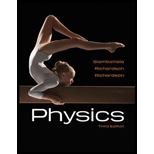
Concept explainers
(a)
The separation between the wires at equilibrium.
(a)
Answer to Problem 87P
The separation between the wires at equilibrium is
Explanation of Solution
Refer figure 1.

Write an expression for the forces acting on a wire.
Here,
Rewrite the expression (I) to find
Write an expression for the Newton’s second law for one wire.
Here,
Rewrite the expression (III) to find
The forces are repelling. Thus, the current in the wires will be opposite in direction.
Equate equation (II) and (IV).
Rearrange the equation (V) to find
Refer figure 1 to rewrite equation (VI).
For small angle approximation
Substitute
Here,
Write an expression for the force due to the wires.
Here,
Equate equation (VII) and (VIII).
Rearrange the equation to find
Conclusion:
Substitute
Thus, the separation between the wires at equilibrium is
(b)
The direction of the current in the wires.
(b)
Answer to Problem 87P
The currents in the wires will be opposite in directions.
Explanation of Solution
Write an expression for the force due to the current in the wire.
Here,
According to Fleming’s right hand rule, if the thumb, the index finger and the middle finger of the right hand are kept mutually perpendicular to each other and if the middle finger points in the direction of magnetic field, and the index finger points in the direction of current, then the thumb points in the direction of the force. Thus, to get a repulsive force, the current through the wires should be opposite to each other.
(c)
If the forces in the wires are consistent with
(c)
Answer to Problem 87P
Yes, the forces in the wires are consistent with Newton’s third law of motion.
Explanation of Solution
The currents in the wires are different. The magnitude of the magnetic fields differs with the magnitude of current through the wires. Thus, the fields created by current through the wires are different.
However, the forces acting on the wires are the same in magnitude and opposite in direction. The wires hang away from the vertical at equal angles. Thus, the forces in the wires are consistent with Newton’s third law of motion.
Want to see more full solutions like this?
Chapter 19 Solutions
Physics - With Connect Access
 College PhysicsPhysicsISBN:9781305952300Author:Raymond A. Serway, Chris VuillePublisher:Cengage Learning
College PhysicsPhysicsISBN:9781305952300Author:Raymond A. Serway, Chris VuillePublisher:Cengage Learning University Physics (14th Edition)PhysicsISBN:9780133969290Author:Hugh D. Young, Roger A. FreedmanPublisher:PEARSON
University Physics (14th Edition)PhysicsISBN:9780133969290Author:Hugh D. Young, Roger A. FreedmanPublisher:PEARSON Introduction To Quantum MechanicsPhysicsISBN:9781107189638Author:Griffiths, David J., Schroeter, Darrell F.Publisher:Cambridge University Press
Introduction To Quantum MechanicsPhysicsISBN:9781107189638Author:Griffiths, David J., Schroeter, Darrell F.Publisher:Cambridge University Press Physics for Scientists and EngineersPhysicsISBN:9781337553278Author:Raymond A. Serway, John W. JewettPublisher:Cengage Learning
Physics for Scientists and EngineersPhysicsISBN:9781337553278Author:Raymond A. Serway, John W. JewettPublisher:Cengage Learning Lecture- Tutorials for Introductory AstronomyPhysicsISBN:9780321820464Author:Edward E. Prather, Tim P. Slater, Jeff P. Adams, Gina BrissendenPublisher:Addison-Wesley
Lecture- Tutorials for Introductory AstronomyPhysicsISBN:9780321820464Author:Edward E. Prather, Tim P. Slater, Jeff P. Adams, Gina BrissendenPublisher:Addison-Wesley College Physics: A Strategic Approach (4th Editio...PhysicsISBN:9780134609034Author:Randall D. Knight (Professor Emeritus), Brian Jones, Stuart FieldPublisher:PEARSON
College Physics: A Strategic Approach (4th Editio...PhysicsISBN:9780134609034Author:Randall D. Knight (Professor Emeritus), Brian Jones, Stuart FieldPublisher:PEARSON





